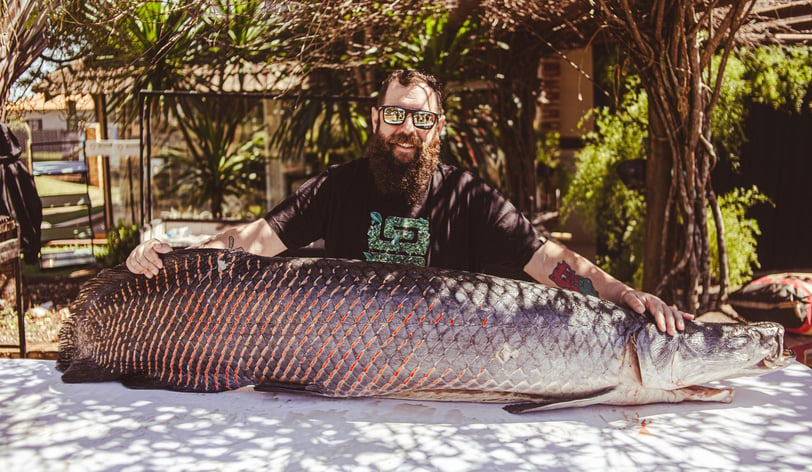Pirarucu: The Forgotten Superfood That Makes Salmon Look Ordinary
Imagine a fish the size of a car with snow-white, subtly sweet flesh. Discover the wonder of pirarucu, the Amazonian giant that will change how you think about seafood.
HEALTHY DISHES
CILZA DUARTE
4/20/20257 min read


The Amazon's Protein King: Introducing Pirarucu.
The first time I saw a pirarucu being pulled from the waters of the Amazon, I actually laughed in disbelief. It seemed impossible—a fish the size of a small car, armor-plated and prehistoric-looking, thrashing with primal energy. "That can't possibly be good eating," I whispered to my guide. Hours later, as I tasted my first bite of this remarkable creature's snow-white flesh, I realized I'd been spectacularly wrong. The delicate, flaky meat melted on my tongue with a subtle sweetness that defied its monstrous appearance.
What struck me even more profoundly was learning that this Amazonian giant—virtually unknown in North American and European kitchens—puts many of our celebrated "healthy" fish choices to nutritional shame. While we've been obsessing over salmon and its omega-3 content, indigenous Amazonians have quietly been enjoying a nutritional powerhouse that deserves global recognition.
The Ancient Giant Swimming Beneath the Surface
The pirarucu (Arapaima gigas)—also known as paiche in some regions—isn't just another fish. It's one of the largest freshwater fish on the planet, capable of growing up to 10 feet long and weighing over 400 pounds. Its massive size alone makes it a remarkable species, but what's truly extraordinary is that this living fossil has remained largely unchanged for millions of years.
Indigenous communities throughout the Amazon basin have revered the pirarucu not just as a food source but as a creature of mythological significance. Its distinctive red-tinged scales were traditionally used for nail files and jewelry, while its tongue—rough as sandpaper—served as a grater for guaraná seeds and medicinal plants. Waste not, want not, as the saying goes, but Amazonians perfected this principle centuries ago.
Yet it's the pristine white flesh of this magnificent creature that delivers truly remarkable nutrition. And let me tell you—it makes an unforgettable meal.
Protein Content That Defies Comparison
Let's start with the most obvious nutritional benefit: protein content. A standard 4-ounce serving of pirarucu contains approximately 28-30 grams of complete protein—significantly more than salmon (about 22-25 grams) and most other commercial fish varieties.
But the protein story gets even more interesting when we examine the amino acid profile. Pirarucu provides exceptional levels of lysine and leucine—two essential amino acids crucial for muscle repair and growth. This unique amino acid balance makes pirarucu particularly valuable for:
Athletic recovery
Maintaining muscle mass during aging
Supporting immune function
Facilitating tissue repair
Even more remarkable is the protein digestibility score. Unlike some protein sources that look good on paper but prove difficult for the body to fully utilize, pirarucu protein shows exceptionally high bioavailability. The protein digestibility-corrected amino acid score (PDCAAS) approaches egg protein—long considered the gold standard for protein quality.
Now, I know what you're thinking: "High-protein fish aren't that unusual." But what makes pirarucu extraordinary is how this substantial protein content comes with remarkably low fat levels—less than 1.5% total fat in wild-caught specimens. Try finding another fish that delivers that kind of protein punch with so little accompanying fat. (Go ahead, I'll wait.)
The B12 Bonanza Your Body Craves
If there's one micronutrient that deserves special attention when discussing pirarucu, it's vitamin B12. This essential vitamin—critical for nerve function, DNA synthesis, and red blood cell formation—is notoriously difficult to obtain in adequate amounts, especially for those limiting animal products.
A single 4-ounce serving of pirarucu delivers an astonishing 8-10 micrograms of vitamin B12—approximately 400% of the recommended daily intake. Comparing this to other common fish:
Salmon: 2.4 mcg per 4-ounce serving
Tuna: 2.5 mcg per 4-ounce serving
Cod: 1.2 mcg per 4-ounce serving
This extraordinary B12 content makes pirarucu particularly valuable for:
Older adults (who often have decreased B12 absorption)
Individuals taking certain medications that impair B12 absorption
Anyone experiencing fatigue or neurological symptoms
People following plant-forward diets who need concentrated B12 sources
The high B12 content isn't just impressive in quantity—the form found in pirarucu appears to have excellent bioavailability compared to supplements. This means your body can actually use what you're consuming, rather than simply passing it through.
"É um peixe abençoado," as Amazonians often say—"It's a blessed fish." And for those struggling with B12 deficiency, this blessing takes on very practical significance.
Omega-3 Profile: Quality Over Quantity
While much attention has been paid to the omega-3 content of fatty fish like salmon and mackerel, the omega-3 story in pirarucu takes a fascinating turn. Though lower in total fat than oily fish, the fat pirarucu does contain has an exceptional omega-3 to omega-6 ratio—approximately 4:1 in wild specimens.
This ratio matters tremendously. Modern Western diets typically deliver omega-6 to omega-3 ratios of 15:1 or even 20:1—far from the 4:1 or lower ratio that research suggests is optimal for human health. Finding foods that help correct this imbalance becomes increasingly important.
A typical 4-ounce serving of pirarucu provides approximately:
650-800mg of omega-3 fatty acids
150-200mg of omega-6 fatty acids
While the total omega-3 content is indeed lower than fatty fish like salmon (which might provide 1,500-2,000mg per serving), the superior ratio and unique composition may offer distinctive benefits.
Particularly interesting is pirarucu's content of docosapentaenoic acid (DPA)—an often-overlooked omega-3 that research suggests may have unique anti-inflammatory properties. Some studies indicate that DPA may be particularly effective at modulating inflammatory processes in ways that complement but differ from the more commonly discussed EPA and DHA.
Mineral Content: The Overlooked Nutritional Dimension
What truly distinguishes pirarucu from many other fish species is its impressive mineral profile. The unique ecosystem of the Amazon, with its mineral-rich waters flowing from the Andes, creates a distinctive nutritional signature in this remarkable fish.
A standard serving provides exceptional amounts of:
Selenium: Approximately 40-45mcg (about 80% of daily needs)
Phosphorus: Around 300mg (30% of daily requirements)
Potassium: Approximately 500-550mg (15% of daily needs)
Iron: About 2.5mg (15% of daily requirements)
Zinc: Approximately 1.8-2mg (15-20% of daily needs)
This mineral wealth supports everything from thyroid function and immune response to energy production and oxygen transport. (And honestly, when was the last time your nutritionist mentioned the importance of getting enough phosphorus?)
The selenium content deserves special attention, as this mineral plays a crucial role in antioxidant pathways and may help protect against mercury toxicity—a common concern with larger fish. The high selenium-to-mercury ratio in properly sourced pirarucu helps mitigate potential heavy metal concerns.
From Ancient Tradition to Modern Sustainability
Traditionally, indigenous communities harvested pirarucu using harpoons—a skill requiring intimate knowledge of the fish's behaviors and extraordinary precision. These traditional methods naturally limited harvest to sustainable levels. As commercial interest in pirarucu has grown, however, sustainable management has become crucial.
The good news is that pirarucu farming and managed wild harvesting have emerged as remarkable success stories in sustainable aquaculture. Unlike many farmed fish operations that create environmental problems, properly managed pirarucu production can actually support rainforest conservation and indigenous livelihoods.
Several factors make pirarucu exceptionally well-suited for sustainable production:
Air-breathing capability (reducing oxygenation requirements)
Omnivorous diet with efficient feed conversion
Rapid growth rate (reaching market size in 12-18 months)
Adaptability to varying water conditions
When sourced from well-managed operations, pirarucu represents one of the most environmentally responsible animal protein choices available. "Quem cuida da água, cuida do peixe" (Those who care for the water, care for the fish), as traditional Amazonian fishers say—a philosophy now backed by modern ecological understanding.
Bringing Amazonian Nutrition to Your Kitchen
For most North Americans and Europeans, obtaining fresh pirarucu remains challenging. However, frozen fillets are increasingly available through specialty seafood suppliers and online sources focusing on sustainable options.
Working with pirarucu in the kitchen reveals another of its remarkable qualities: versatility. The firm, meaty white fillets:
Hold their shape during grilling without falling apart
Absorb marinades readily without becoming mushy
Maintain moisture during baking
Stand up to bold spices without being overwhelmed
Traditional Amazonian preparations often involve simple grilling with lime and regional herbs, but pirarucu adapts beautifully to techniques from other culinary traditions. It makes a spectacular substitute in recipes calling for sea bass, grouper, or halibut—often with superior texture and flavor.
For those concerned about sustainability, seeking pirarucu from certified sources ensures you're supporting responsible management rather than contributing to overfishing. The Marine Stewardship Council and similar organizations have begun certifying well-managed pirarucu operations.
The Future of Ancient Nutrition
What fascinates me most about pirarucu is how it represents both ancient wisdom and future potential. Indigenous communities understood its nutritional value through generations of observation and experience. Modern nutritional science now confirms and expands upon this traditional knowledge.
As global food systems face increasing challenges from climate change and population growth, this remarkable fish offers valuable lessons in sustainable protein production. Unlike many conventional livestock operations that require massive land clearing and resource inputs, well-managed pirarucu production works with Amazonian ecosystems rather than against them.
This integration of traditional knowledge with modern understanding creates a powerful model for addressing nutritional needs while supporting environmental health. It's what Amazonians would call "sabedoria antiga para problemas modernos"—ancient wisdom for modern problems.
Beyond Nutrition: The Cultural Dimension
To fully appreciate pirarucu, we must recognize that it represents not just exceptional nutrition but living cultural heritage. For countless generations, this magnificent fish has been woven into the fabric of Amazonian communities—appearing in creation myths, traditional medicines, and communal harvest celebrations.
When we embrace foods like pirarucu, we're not simply adding nutrients to our diet; we're connecting with traditional foodways that have sustained human health for centuries. In an era of increasingly processed and disconnected food systems, these connections matter profoundly.
As one elderly fisherman in Mamirauá Sustainable Development Reserve told me, "O pirarucu não é só comida; é nossa história" (The pirarucu isn't just food; it's our history). His weathered hands, precise and powerful when wielding a traditional harpoon, testified to a lifetime of relationship with this remarkable creature.
Finding Balance in Ancient Wisdom
Our modern nutritional landscape often oscillates between extremes—demonizing entire food groups or elevating specific "superfoods" to mythical status. What traditional foodways like those involving pirarucu offer is something more nuanced: an understanding of how specific foods fit within balanced, sustainable dietary patterns.
The indigenous communities who have harvested pirarucu for countless generations didn't isolate its nutritional components or calculate its protein content. They observed how this remarkable fish supported health when consumed as part of seasonal, diverse diets deeply connected to local ecosystems.
Perhaps there's wisdom in this integrated approach—one that values nutritional density while recognizing that true nourishment comes from broader patterns of eating, gathering, and connecting.
So while I marvel at pirarucu's impressive protein content, extraordinary B12 levels, and unique omega-3 profile, what truly inspires me is the holistic nutritional intelligence it represents. This ancient giant, swimming in Amazonian waters for millions of years, offers lessons about sustainability, nutrition, and cultural continuity that we're only beginning to fully appreciate.
Next time you're seeking to diversify your protein options or explore nutritional frontiers beyond the familiar, consider looking to the Amazon. This remarkable fish—once known only to indigenous communities and adventurous travelers—might just represent one of nature's most perfect nutritional packages.
Visit www.myamazonfood.com for sustainably sourced pirarucu and discover recipes that bring the nutritional wonders of the Amazon to your table.
Inspiration - Health
Explore recipes, tips, and culinary articles today.
wellness
Flavor
cilzaduarte@gmail.com
55 81 98087-8684
© 2025. All rights reserved.
